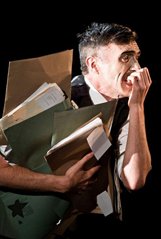If ever there was a literary masterpiece ripe and ready for theatrical adaptation by The Corn Exchange, it’s James Joyce’s Dubliners. Joyce’s collection of short stories, capturing intimate portraits of Dublin at the turn of the twentieth century, is richly populated with characters from nearly every strata of society, each imbued with a carefully constructed humanity. Taken together, the collection behaves like a chameleon performer, effortlessly slipping in and out of differing circumstances, transforming itself before our eyes but still maintaining a strange, baseline familiarity in the form of Joyce’s own distant compassion for his characters. The Corn Exchange, armed with its varying approaches to commedia dell’arte, as well as the ability to use mime and inventive moments of transformation to create whole worlds in the mind of the audience, has tread this sort of territory before. Dublin By Lamplight (2004), itself a satirical portrait of 1904 Dublin peopled with cartoonish oddballs, and Everyday (2006), a portmanteau story of Celtic Tiger Dublin, feel as if they could have been workshop rehearsals in preparation for the challenge of tackling Joyce’s ode to the Big Smoke. But where both of those productions exhibited a sense of improvisational danger and an exciting irreverence, here The Corn Exchange seems, at times at least, to treat Joyce’s material with kid gloves.
The production opens with the ensemble wandering out on stage, one by one, to the lonesome strains of composer Conor Linehan’s haunting score, until a host of bodies stand before us. This evocative opening suggests a conjuring of the ghosts of the city’s former inhabitants, who perhaps still walk Grafton Street or lurk about the gates of Stephen’s Green. However, this eerie solemnity, arresting at first, is carried over into the proceeding narrative and is nearly in danger of swamping the momentum of first two episodes. Here a young, bespectacled narrator recalling a young Joyce, narrates two tales in the first person: that of the death of a priest he’d been friendly with, and a strange encounter he and a school chum have with an odd, vaguely menacing man during a day of mitching. Left intact for the most part is Joyce’s finely crafted phrasing, which actually could have been trimmed a bit, even paraphrased, in order to quicken the slackening pace. Also, this approach suggested briefly that director Annie Ryan and writer Michael West had chosen to make their adaptation some kind of literal memory play, with Joyce relating to us in text-heavy passages the stories of Dubliners, as if we were watching the embodiment of some kind of gauzy reminiscence.
 Thankfully, this proves not to be the case, and the frantic, grotesque satire The Corn Exchange is known for wins out. As first person narration gives way to third, director Ryan and her extremely talented ensemble artfully turn narrative into action. Characters relate their stories directly to the audience, moment to moment, at once living a story and reporting it. This creates a fantastic dramatic tension of its own, as characters become painfully aware of the narrative path they’re tethered to and are inevitably doomed to complete. This style of performance is most effective when it lures the audience in with overt comic displays that are ultimately undermined by withering details illustrating a character’s emotional or mental fragility. Drunkards and fools who earn guffaws from the audience are the next moment revealed as explosively violent or hopelessly broken, continuously disrupting assumptions of what’s being presented.
Thankfully, this proves not to be the case, and the frantic, grotesque satire The Corn Exchange is known for wins out. As first person narration gives way to third, director Ryan and her extremely talented ensemble artfully turn narrative into action. Characters relate their stories directly to the audience, moment to moment, at once living a story and reporting it. This creates a fantastic dramatic tension of its own, as characters become painfully aware of the narrative path they’re tethered to and are inevitably doomed to complete. This style of performance is most effective when it lures the audience in with overt comic displays that are ultimately undermined by withering details illustrating a character’s emotional or mental fragility. Drunkards and fools who earn guffaws from the audience are the next moment revealed as explosively violent or hopelessly broken, continuously disrupting assumptions of what’s being presented.
Ryan’s design team also impresses. Joe Vanek’s set suggests the incongruous nature of Dublin architecture, where arches and stone walls several hundred years old share space with the exposed concrete and metal superstructure of a modern building under construction. His costumes also echo this spanning of time periods, mixing Edwardian detail with hemlines and patterns recalling the forties or fifties. Sinead McKenna’s lighting effortlessly brings into being the multitude of spaces in which Dubliners takes place, aided by Jack Phelan’s ghostly video design.
But the range, depth and energy of the ensemble, combined with Ryan’s direction, almost makes even a technically well-executed design superfluous. This is especially true when the possibilities of performance override any reverence for Joyce’s original text, and the imagination of the performer is trusted to create the setting through body and voice, and not just an inventive lighting or sound cue. While this is a solid adaptation of a universal classic, its own inventiveness is dampened slightly by a reverential kneading of Joyce’s words, rather than a genuine attempt to explode or reinvent them.
Jesse Weaver was awarded a PhD in Theatre Studies from UCC, and is a playwright.